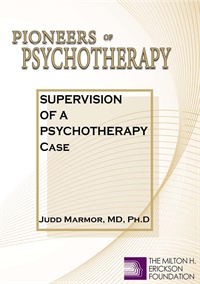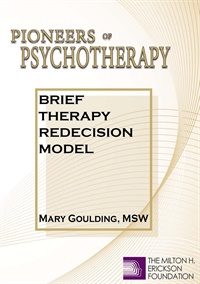
- Average Rating:
- Not yet rated
- Topic Areas:
- Clinical Demonstrations | Meditation, Spirituality and Yoga | Psychotherapy | Interviewing
- Bundle(s):
- Pioneers of Psychotherapy Bundle
- Categories:
- Pioneers of Psychotherapy | Evolution of Psychotherapy | Evolution of Psychotherapy 2009
- Faculty:
- James Hillman, PhD
- Course Levels:
- Master Degree or Higher in Health-Related Field
- Duration:
- 00:53:00
- Format:
- Audio and Video
- Original Program Date:
- Dec 10, 2009
- Short Description:
- James Hillman (2009) Hillman reveals how to bring “soul talk” back into modern psychotherapy. The case history of a client is the diagnosis, present complaint, family history, employment history, but nothing of the “soul” of the person. Dr. Hillman assures us that we can almost ignore the case history. Using “soul” talk (Longings, dreams, secrets, how a client accepts joy and sorrow) takes the session out of the box and returns a resonance to psychotherapy that it has lost.
- Price:
- $59.00 - Base Price

- Average Rating:
- Not yet rated
- Topic Areas:
- Clinical Demonstrations | Ericksonian Hypnosis and Therapy Techniques | Ericksonian Psychotherapy | Utilization | Humor | Hypnosis | Psychotherapy
- Bundle(s):
- Pioneers of Psychotherapy Bundle
- Categories:
- Pioneers of Psychotherapy | Evolution of Psychotherapy | Evolution of Psychotherapy 1995
- Faculty:
- Jeffrey Zeig, PhD
- Course Levels:
- Master Degree or Higher in Health-Related Field
- Duration:
- 00:57:00
- Format:
- Audio and Video
- Original Program Date:
- Dec 14, 1995
- Short Description:
- Zeig (1995) demonstrates the Ericksonian approach to psychotherapy while working with Carol, a woman whose nail-biting habit is rooted in anxiety. After gathering information on her personal history, Zeig helps Carol utilize her values and history to affect change. The process is both humorous and dramatic. After working to change associations linked to the problem behavior, Zeig offers Carol an ordeal that will produce a "guaranteed cure." Hypnosis is offered as the "dessert", rather than the main course. Ericksonian approach to psychotherapy.
- Price:
- $59.00 - Base Price

- Average Rating:
- Not yet rated
- Topic Areas:
- Clinical Demonstrations | Dreamwork | Gottman Method | Psychotherapy
- Bundle(s):
- Pioneers of Psychotherapy Bundle
- Categories:
- Pioneers of Psychotherapy | Evolution of Psychotherapy | Evolution of Psychotherapy 2005
- Faculty:
- John Gottman, PhD | Julie Gottman, PhD
- Course Levels:
- Master Degree or Higher in Health-Related Field
- Duration:
- 00:59:00
- Format:
- Audio and Video
- Original Program Date:
- Dec 09, 2005
- Short Description:
- John Gottman and Julie Gottman (2005) demonstrate through role-playing the ways therapists can break a couples’ gridlock due to conflict. Through an intervention of “dreams within the conflict,” therapists are shown how to help couples be more open for dialogue in order to successfully compromise on unresolvable issues.
- Price:
- $59.00 - Base Price

- Average Rating:
- Not yet rated
- Topic Areas:
- Clinical Demonstrations | Anxiety | Psychotherapy
- Bundle(s):
- Pioneers of Psychotherapy Bundle
- Categories:
- Pioneers of Psychotherapy | Evolution of Psychotherapy | Evolution of Psychotherapy 1985
- Faculty:
- Joseph Wolpe, M.D.
- Course Levels:
- Master Degree or Higher in Health-Related Field
- Duration:
- 00:57:00
- Format:
- Audio and Video
- Original Program Date:
- Dec 10, 1985
- Short Description:
- Joseph Wolpe (1985) begins with Santiago who has a history of experiencing strong feelings of anxiety and discomfort during social situations. Questioning reveals that these problems are most intense when he is in situations in which he experiences a loss of control. Wolpe uses imagery and desensitization to diminish feelings of anxiety.
- Price:
- $59.00 - Base Price
Tags: Anxiety Psychotherapy

- Average Rating:
- Not yet rated
- Topic Areas:
- Clinical Demonstrations | Psychotherapy | Trauma | Aging and Mortality
- Bundle(s):
- Pioneers of Psychotherapy Bundle
- Categories:
- Pioneers of Psychotherapy | Evolution of Psychotherapy | Evolution of Psychotherapy 1990
- Faculty:
- Joseph Wolpe, M.D.
- Course Levels:
- Master Degree or Higher in Health-Related Field
- Duration:
- 00:56:00
- Format:
- Audio and Video
- Original Program Date:
- Dec 14, 1990
- Short Description:
- Joseph Wolpe (1990) interviews police officer Tom, who has problems resulting from a traumatic event: he had been confronted by a violent man whom he shot and killed. Later it became evident that the man had an empty gun and was mentally ill. Following a thorough interview, Wolpe uses eye movement and systematic desensitization to diminish the established fear hierarchy.
- Price:
- $59.00 - Base Price

- Average Rating:
- Not yet rated
- Topic Areas:
- Clinical Demonstrations | Psychotherapy | Brief Therapy | Supervision
- Bundle(s):
- Pioneers of Psychotherapy Bundle
- Categories:
- Pioneers of Psychotherapy | Evolution of Psychotherapy | Evolution of Psychotherapy 1990
- Faculty:
- Judd Marmor
- Course Levels:
- Master Degree or Higher in Health-Related Field
- Duration:
- 00:59:00
- Format:
- Audio and Video
- Original Program Date:
- Dec 12, 1990
- Short Description:
- Judd Marmor (1990) outlines the history of brief dynamic psychotherapy by outlining the psychotherapy beginning with Freud and psychoanalysis. He profiles patients he believes will benefit from short-term therapy. He then conducts supervision with two volunteers. Following the demonstration Marmor discusses his technique.
- Price:
- $59.00 - Base Price

- Average Rating:
- Not yet rated
- Topic Areas:
- Clinical Demonstrations | Psychotherapy | Chain Analysis | Therapist Development
- Bundle(s):
- Women Pioneers of Psychotherapy | Pioneers of Psychotherapy Bundle
- Categories:
- Pioneers of Psychotherapy | Evolution of Psychotherapy | Evolution of Psychotherapy 2009
- Faculty:
- Marsha Linehan, PhD
- Course Levels:
- Master Degree or Higher in Health-Related Field
- Duration:
- 00:57:00
- Format:
- Audio and Video
- Original Program Date:
- Dec 10, 2009
- Short Description:
- Marsha Linehan (2009) provides dynamic, engaging demonstrations with two separate volunteers using nonjudgmental “chain analysis” to identify their problem behavior and look for controlling variables. Rather than using self-discipline, she suggests practical methods such as listing pros and cons and setting up consequences if the behavior continues. Both volunteers reported great satisfaction with the process.
- Price:
-
Nate Sub 1.1 Price is $0.00
price reduced from Base Price - $59.00

- Average Rating:
- Not yet rated
- Topic Areas:
- Clinical Demonstrations | Redecision Therapy | Brief Therapy | Psychotherapy | Relationships
- Bundle(s):
- Women Pioneers of Psychotherapy | Pioneers of Psychotherapy Bundle
- Categories:
- Pioneers of Psychotherapy | Evolution of Psychotherapy | Evolution of Psychotherapy 1995
- Faculty:
- Mary Goulding, MSW
- Course Levels:
- Master Degree or Higher in Health-Related Field
- Duration:
- 00:59:00
- Format:
- Audio and Video
- Original Program Date:
- Dec 15, 1995
- Short Description:
- Mary Goulding (1995) demonstrates with three volunteer clients. The first is disturbed because his mother did not spend much time with him during childhood. Next Dave is concerned about his distant relationship with his son. The third, Diane describes problems with her mother who is now a widow and overly critical. Goulding explains her work.
- Price:
- $59.00 - Base Price

- Average Rating:
- Not yet rated
- Topic Areas:
- Clinical Demonstrations | Group Therapy | Redecision Therapy | Psychotherapy | Confrontation | Humor
- Bundle(s):
- Pioneers of Psychotherapy Bundle
- Categories:
- Pioneers of Psychotherapy | Evolution of Psychotherapy | Evolution of Psychotherapy 1985
- Faculty:
- Mary Goulding, MSW | Robert L. Goulding, MD
- Course Levels:
- Master Degree or Higher in Health-Related Field
- Duration:
- 00:58:00
- Format:
- Audio and Video
- Original Program Date:
- Dec 13, 1985
- Short Description:
- Robert and Mary Goulding (1985), working as cotherapists, demonstrate using five volunteer clients. The concerns of each individual are addressed during the therapy session. The Gouldings help define each person’s goals and establish a contract for change. The session includes role-play, fantasy, confrontation and the use of humor.
- Price:
- $59.00 - Base Price
- Average Rating:
- Not yet rated
- Topic Areas:
- Milton Erickson | Multicultural | Psychotherapy | Ericksonian Hypnosis and Therapy Techniques | Utilization | Hypnosis | Strategic Therapy
- Categories:
- Erickson Streaming Video Collection | Erickson Materials | Milton H. Erickson Collections
- Faculty:
- Jeffrey Zeig, PhD | Milton H. Erickson, MD
- Course Levels:
- Master Degree or Higher in Health-Related Field
- Duration:
- 59 Minutes
- Format:
- Audio and Video
- Original Program Date:
- Aug 13, 2020
- Short Description:
- Milton Erickson often advised psychotherapy students to study anthropology so that therapy could be provided from the perspective of the cultural background of the client. In the video, Erickson uses his understanding of cultural orientation when working with an adolescent where the presenting problem is a speech defect. This is a highly informative case of using strategic and systemic processes that can be applied to other presenting problems.
- Price:
- $19.95 - Base Price
Please wait ...


